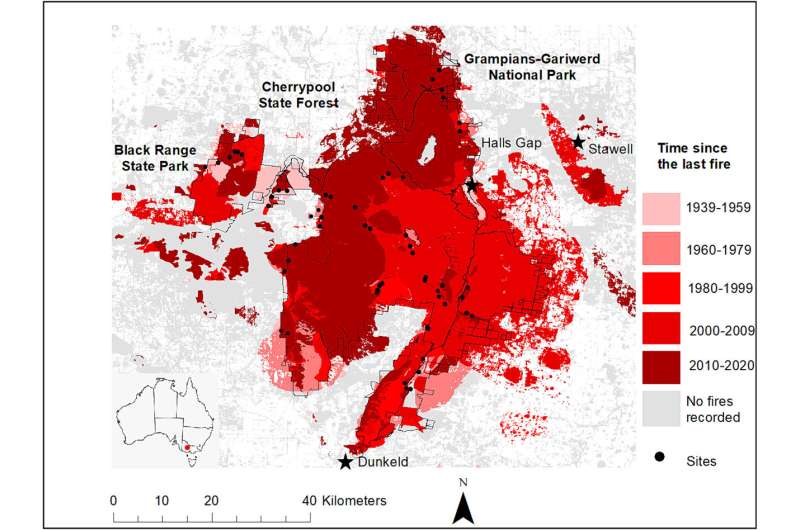This article has been reviewed according to Science X's editorial process and policies. Editors have highlighted the following attributes while ensuring the content's credibility:
fact-checked
peer-reviewed publication
trusted source
proofread
Understanding how fire shapes plants can help protect them

Fire is an important part of plant life in Australia, influencing where plants grow and how abundant a species will be.
As a result of recurring bushfires and cultural fire over millennia, many plants have developed adaptations which help them thrive in fire-prone ecosystems.
You may be familiar with the amazing new shoots that appear quickly on the trunks of many eucalypt species after fire—this is an adaptation referred to as resprouting.
Other incredible adaptations—or traits—are flowering and germination induced by fire, and thick and fibrous bark that protects plants from heat and flames.
However, fire activity is changing across the globe and testing the limits of plant adaptations. These changes to fire activity, including increases in the frequency of large fires in southern Australia, are threatening thousands of plant species.
But what about if we could predict how fire affects plant species?
If we could develop robust predictions of how plant populations change over large areas and through time, this would provide essential knowledge to make decisions about how to manage fire to protect plant species.
And what if we could generalize these predictions to species that share similar kinds of traits?
This would strengthen the evidence base for conservation management and enable more effective management of the tremendous diversity of plant life that supports life on Earth.
In our new study, published in Biological Conservation, we tested if we could predict how different plant populations would change in the decades following fire.
We brought together a wealth of knowledge on the traits that plant species exhibit in response to fire, including whether or not they are stimulated to resprout or germinate by fire and how fast they grow and produce seed.
We then grouped species into categories based on these traits and made predictions for how the abundance of species in each of these groups would change based on time since the last fire.
We tested our predictions by collecting plant data across Gariwerd (the Grampians) in western Victoria, at sites that ranged from 0 to 81 years post-fire. Statistical analysis enabled us to understand how well our predictions matched what we found in the field.
We found accurate predictions of plant abundance could be made for 75% of species. For example, we correctly predicted a species dependent on regeneration from seeds, the Oyster Bay Pine, would take 80 years to peak in abundance.
Our observations of the Prickly Teatree peaking in abundance about 30 years after a fire, a species that resprouts, also conformed with predictions.
Being able to use knowledge of how plants respond to fire will help scientists, land managers and communities to make better decisions to protect plant diversity.
For example, knowing where, when, and how plants respond to fire will help land managers decide when to apply planned fires and when to enact fire suppression efforts.
Using this knowledge will only be more important as fire activity continues to change. In Gariwerd, for example, some locations have experienced five to six large fires in only a few decades.
We also identified ways that predictions about plants can be improved. Notably, by collecting more field data on plant traits in different ecosystems and under different types of bushfires and planned fires.
Continuing to develop knowledge about fire and plants will help to protect them into the future.
More information: Ella Plumanns-Pouton et al, Using plant functional types to predict the influence of fire on species relative abundance, Biological Conservation (2024). DOI: 10.1016/j.biocon.2024.110555
Journal information: Biological Conservation
Provided by University of Melbourne




















